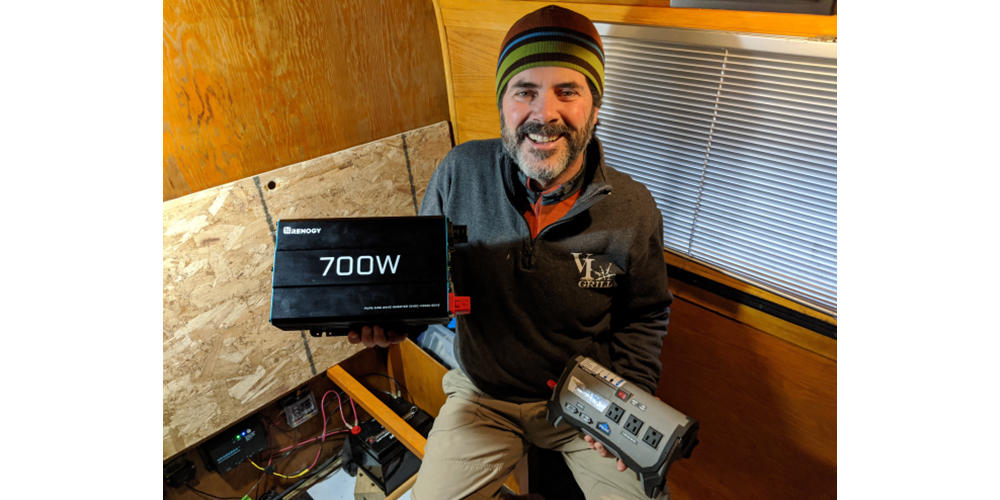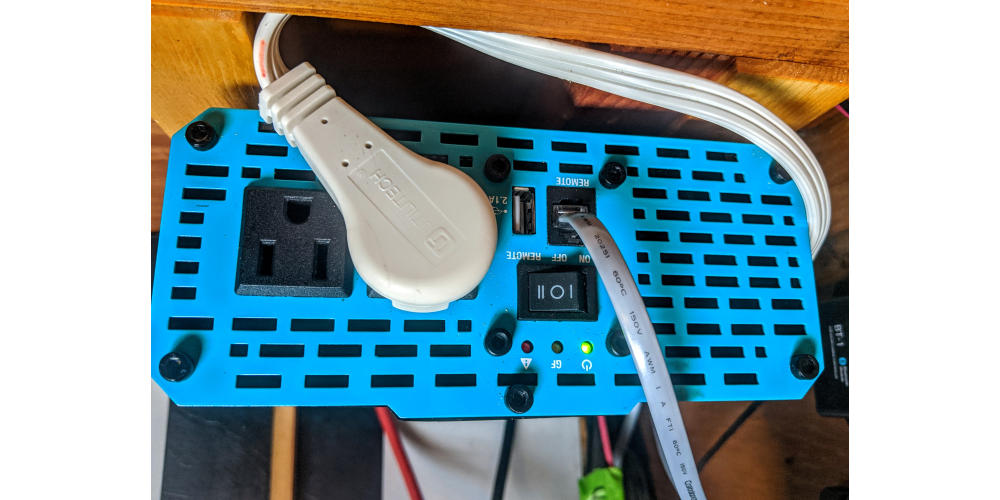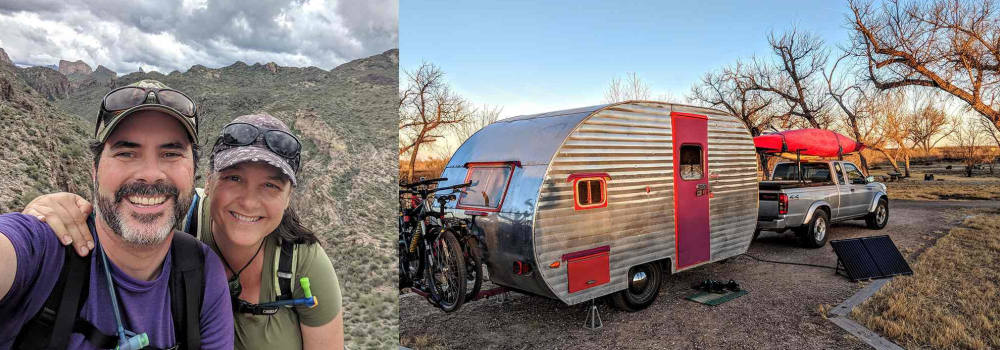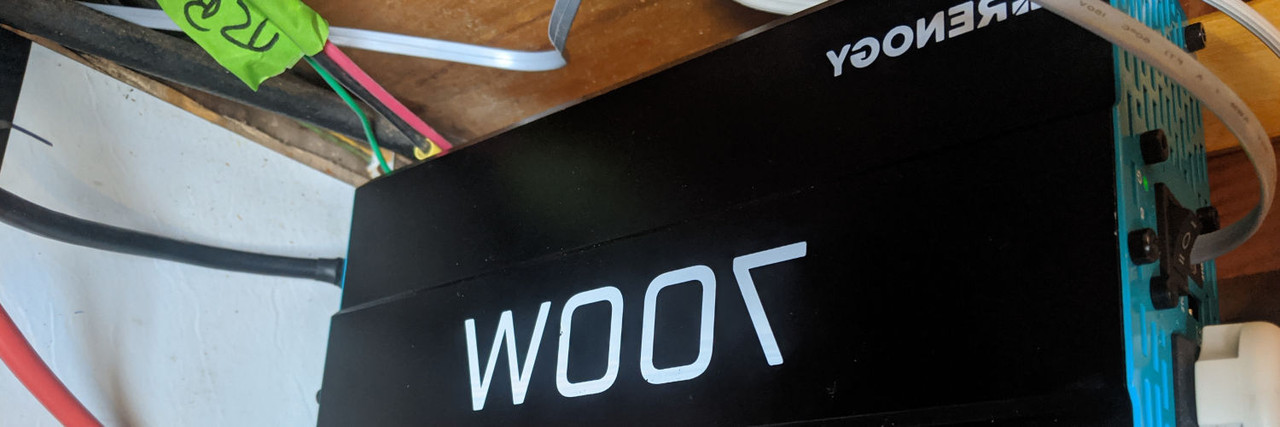OUT with the Old, INverter with the New!
When we started out this mobile living venture 7.5 years ago, we had a very small solar powered system designed by our friends at IONCON of Boone, NC. It was perfect for quite a few years. Since that time our electrical needs have changed, and options for 12V LED lighting and USB charging have significantly improved.

To kick off 2020 in style, we decided to upgrade our electrical system to increase the efficiency and reduce our overall watt hours so that our battery can last longer. We removed our old 120V LED rope light and installed 12V LED lights encased in a stylish silicone strip which are both weatherproof and can be dimmed via remote control, thus further saving energy. We also created a USB charging station with 5 ports and have wired it directly to the battery via a new fuse box. These two upgrades alone have improved our efficiency as they merely sip from our battery. But, we decided to take it a step further…

Within the past year, we upgraded both our charge controller and battery, so the final upgrade was to install a larger and more efficient inverter. Since we still have very simple electrical needs (only running about 200-300W at any given time with a 50Ah Lithium battery) we chose Renogy’s smallest inverter, a 12V 700W Pure Sin Wave. Having lived with it for about 6 weeks now, we are very pleased with its performance! Check out our video of the installation! For an overview of our entire system and a special discount on your next Renogy order, visit our website.

12V 700W Pure Sin Wave Inverter Product Features
●Optimized for 12 VDC system voltage.
●Offers high quality waveform with little harmonic distortion.
●Overload protection for both DC input and AC output to prevent damage to the components and the unit.
●Special LED indicators for under-voltage and over-voltage protection, over-temperature protection, over-load protection, and short circuit indication.
●High-speed ventilation fans to help keep the inverter running at a low temperature.
●Ground-fault circuit interrupter (GFCI) protection.
●3’ 6AWG cables and remote switch with 18’ wire included in package.

A few things we love about this new inverter:
More efficient: By moving our inverter closer to our battery (Renogy recommends less than 5 feet) and increasing the gauge size of our wire, we have created a more efficient transfer of power between the battery and inverter. In addition, this inverter is a Pure Sin Wave style, which offers high quality waveform with little harmonic distortion.
Quieter: Our old 400W inverter had a fan that would kick on to cool the unit down, especially when the weather was warmer or we were running a number of different electronics at the same time. While we got used to the noise of the fan, the new inverter’s fan is so quiet and doesn’t need to kick on very often. There is no static or humming noise at all.
More powerful: By increasing our inverter from a 400W to 700W unit and augmenting the size of our wiring from 10 gauge to 6 gauge, we can get higher amperage flowing through our system. We can now run appliances such as a stick blender, heating pad/electric blanket, and even a small vacuum cleaner all without plugging into shore power!
Remote switch: With our old unit, we had to open the cabinet above the sink to switch on the inverter anytime we wanted to run A/C power. While this was certainly not a huge inconvenience, it did require us to step completely inside the camper just to turn the lights on. The 700W inverter came with a small remote switch which we have mounted by the camper door. Waalllaah, problem solved!
Robust installation: Using the brackets on the bottom of the inverter, we were able to mount it easily to the wall underneath our bench seats. The unit is very well-constructed overall.
While we have found very few drawbacks to this inverter, here are a couple:
Larger and heavier: This unit (11.75 x 7.38 x 3.32 inches) is about 1.5 times the size of our old inverter, and at least twice the weight (5.3 lbs). At first, we weren’t sure if such a large inverter would fit into our tiny space, but with some creativity and rearranging, we found the perfect place under the bench seat of our dining area, within 3 feet of the battery.
Only 1 USB port: Our old inverter had 2 USB ports, but this unit only has one. To overcome this challenge, we wired a 12V remote USB charging station directly to our battery and put it in a convenient location for charging all the small electronics we carry with us – phones, powerbank, bike lights, Bluetooth speaker, etc. Now, we can charge 5 things at once!

A Couple Things to Ask Yourself Before Buying an Inverter...
Do I need an inverter for my solar powered system? If you are just running 12V appliances, you do not need an inverter as you can wire these appliances directly to your battery. But, if you plan to run any 120V household appliances (e.g., coffee maker, toaster, laptop, blender, vacuum cleaner), you will need to convert the DC power coming from your solar panel and battery bank to AC.
How do I determine the size of inverter I need to purchase? To determine which size of inverter you need for your system, calculate your total watt hours, then add a couple hundred watts to your system for safe keeping. If you need to run 800W, choose the 1000W inverter. If you are running various A/C loads, use this rule of thumb for calculating your amp hours .
Do I have a space for an inverter within 5 feet of my battery? Renogy recommends a maximum of 5 feet to reduce power loss between the battery and inverter. But, keep in mind that if you have a lead acid battery (or any other type of battery that can emit gasses), you’ll want to keep the inverter and battery in separate compartments to reduce the potential of a fire.
Overall, we’ve been very pleased with our upgrade and like many of the improvements we keep making to our tiny home, we wonder why we didn’t do it sooner!

Learn more about Shari & Hutch’s solar powered adventures on their website and join them on the road via social media at Facebook, Instagram, and YouTube!











